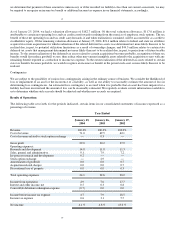NVIDIA 2004 Annual Report Download - page 25
Download and view the complete annual report
Please find page 25 of the 2004 NVIDIA annual report below. You can navigate through the pages in the report by either clicking on the pages listed below, or by using the keyword search tool below to find specific information within the annual report.
If new competitors, technological advances by existing competitors or other competitive factors require us to invest significantly
greater resources than anticipated in research and development or sales and marketing efforts, our business could suffer. We have
substantially increased our engineering and technical resources and have 1,057 full−time employees engaged in research and
development as of January 25, 2004, compared to 832 employees as of January 26, 2003. During fiscal years 2004, 2003 and 2002,
research and development expenditures represented 15%, 12% and 11% as a percentage of revenue, respectively.
Risks Related to Our Products
PCI Express is central to our GPU as well as MCP strategies this year and the outcome of this strategy will impact our
business.
PCI Express is expected to enable a new level of performance for high bandwidth applications like graphics and networking. The
transition to PCI Express, which is extremely complex, is central to our GPU and MCP strategies this year. We intend to lead this
transition using a PCI Express high−speed interconnect, or HSI. HSI is a complex piece of networking technology that performs
high−speed bi−directional interconnect protocol conversion. Using HSI, we expect to transform some of our GPUs into PCI Express
compatible GPUs. With our PCI Express compatible GPUs, we expect that our partners will be able to launch PCI Express compatible
solutions in April 2004. During fiscal 2005, we expect to launch and be in full production with a top−to−bottom product line of next
generation PCI Express GPUs based on our brand new NV4X architecture. If we fail to deliver PCI Express in a timely manner or if
our PCI Express compatible products do not meet consumer and/or analysts expectations, our business could suffer.
We need to develop new products and to manage product transitions in order to succeed.
Our business depends to a significant extent on our ability to successfully develop new products for our target segments. Our add−in
board and motherboard manufacturers, original design manufacturers, or ODMs, and major OEM customers typically introduce new
system configurations as often as twice per year, typically based on spring and fall design cycles. Accordingly, our existing products
must have competitive performance levels or we must timely introduce new products with such performance characteristics in order to
be included in new system configurations. This requires that we do the following:
· anticipate the features and functionality that consumers will demand;
· incorporate those features and functionalities into products that meet the exacting design requirements of OEMs, ODMs, CEMs and
add−in board and motherboard manufacturers;
· price our products competitively; and
· introduce the products to the market within the limited window for OEMs, ODMs, and add−in board and motherboard
manufacturers.
26
As a result, we believe that significant expenditures for research and development will continue to be required in the future. The
success of new product introductions will depend on several factors, including the following:
· proper new product definition;
· timely completion and introduction of new product designs;
· the ability of International Business Machines, or IBM, Taiwan Semiconductor Manufacturing Company, or TSMC, United
Microelectronics Corporation, or UMC, and any additional third−party manufacturers to effectively manufacture our new products in
a timely manner;
· the quality of any new products;
· differentiation of new products from those of our competitors;
· market acceptance of our products and our customers' products; and
· availability of adequate quantity and configurations of various types of memory products.
A critical component of our product development effort is our partnerships with leaders in the computer aided design, or CAD,
industry. We have invested significant resources to develop relationships with industry leaders, including Cadence Design Systems,
Inc., IKOS Systems, Inc. and Synopsys, Inc., often assisting these companies in the product definition of their new products. We
believe that forming these relationships and utilizing next−generation development tools to design, simulate and verify our products
will help us remain at the forefront of the 3D graphics market and develop products that utilize leading−edge technology on a rapid
basis. We believe this approach assists us in meeting the new design schedules of PC manufacturers. If these relationships are not
successful, we may not be able to develop new products in a timely manner.
In addition, our strategy includes utilizing the most advanced semiconductor process technology appropriate for our products and
available from commercial third−party foundries. Use of advanced processes has in the past resulted in initial yield problems. New
products that we introduce may not incorporate the features and functionality demanded by OEMs, ODMs, add−in board and
motherboard manufacturers and consumers of personal computers and consumer electronics. In addition, we may not successfully
develop or introduce new products in sufficient volumes within the appropriate time to meet both the OEMs’ design cycles and market
demand. We have in the past experienced delays in the development of some new products. Our failure to successfully develop,
introduce or achieve market acceptance for new digital media processors would harm our business. In particular, we experienced
























